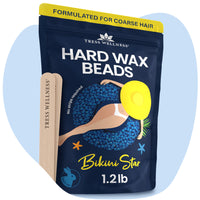Is waxing bad for your skin? While this popular hair removal method promises smoothness, it’s natural to worry about its effects. From minor irritation to the risk of infection, waxing has its potential pitfalls. In this article, we uncover the truth behind waxing, guiding you through its impact on skin health without the fluff.
Key Takeaways
- Waxing is a hair removal method that offers exfoliation and can lead to finer and softer hair over time, but it’s not without discomfort and potential skin irritation.
- The right aftercare, like using products with aloe vera and keeping the skin cool and moisturized, is crucial to minimize side effects like redness, irritation, and ingrown hairs after waxing.
- Consistent waxing can alter hair growth patterns, but laser hair removal may be an alternative for those seeking long-term hair-free results.
Waxing and Skin Health: An Overview

Waxing is a popular hair removal method that offers smooth skin but can sometimes leave us wondering about its effects. Think of facial waxing as a two-in-one hero: it removes unwanted hair and exfoliates dead skin cells. Unlike shaving, which just trims hair, waxing pulls it out by the roots and gets rid of dead skin, giving you longer-lasting results. This extra skin service means we're not just hair-free but also have a fresh layer of skin cells. However, before diving into waxing, let's understand what happens to our skin during and after the process.
Is Waxing Bad for Your Skin?
Opinions about waxing vary—some love the long-lasting smoothness, while others caution about its downsides. But here's the truth: waxing isn't bad for your skin at all. Yes, it can hurt, but if done correctly with proper care, your skin can stay healthy. So, is waxing safe? Absolutely, if you understand how it affects hair follicles and how your skin might react. Let’s explore the world of waxing together.
Understanding the Waxing Process
Imagine each hair as a tenant and waxing as the landlord evicting them. Hot wax, like honey, grabs onto the hair and pulls it out from the root, ensuring it takes longer to grow back compared to shaving. Hard wax needs warmth to work best. The heat opens up hair follicles, making the process easier and less painful. Though it might be uncomfortable, the hot wax ultimately helps reduce pain and ensures smoother hair removal.
Hair Follicle Dynamics Post-Waxing
After waxing, your hair follicles are a bit shocked and weakened. This process not only removes hair but also disrupts the hair bulb at the base. This can lead to hair growing back finer and softer. With regular waxing, these changes might become permanent, leading to less dense and more manageable hair over time.
The Skin's Reaction to Waxing
Waxing can be rough on the skin, causing redness and irritation as it heals. Your skin might also be more prone to infections and, occasionally, bleeding, especially in areas with existing damage. If bleeding persists, consult a doctor. So, does waxing damage skin? Most reactions are minor and manageable with proper care, but it’s essential to understand and mitigate these effects.
Tailoring Wax Selection for Sensitive Skin
If you have sensitive skin, choosing the right wax is crucial. Hard wax is gentle on the skin because it only grabs hair, not skin. Bikini Star Beads are great for sensitive areas like the bikini line, targeting hair without irritating the skin. Using the right tools can make waxing more comfortable for sensitive skin.
The Role of Hard Wax in Reducing Skin Trauma
Hard wax is designed for tender areas and doesn't stick to the skin, making hair removal less traumatic. It efficiently removes even short hair, reducing the need for repeated applications and minimizing skin irritation. For sensitive skin, hard wax is a gentle and effective choice.
Tress Wellness Hard Wax Beads are formulated especially to be tough on the hair and gentle on the skin.
Why Bikini Star Beads are Ideal for Delicate Skin
Bikini Star Beads are specially formulated for sensitive skin, particularly in the bikini area. They grip hair without causing pain, making the waxing experience smoother. These beads respect the delicate balance of sensitive skin, ensuring a more comfortable waxing session.
Identifying and Managing Common Waxing Side Effects

Waxing can cause pain and skin irritation sometimes, especially for sensitive skin. Knowing how to manage these side effects is key. Techniques and aftercare can help prevent and treat issues like infected follicles and breakouts, ensuring your skin stays healthy post-wax. Wondering, is waxing bad for you? With proper care, it doesn’t have to be.
Dealing with Ingrown Hair
Ingrown hairs can be a nuisance, but proper technique and aftercare can help prevent them. Waxing in the direction of hair growth and ensuring complete hair removal can reduce the risk. Aftercare, including gentle exfoliation and hydration, is crucial. For stubborn ingrown hairs, a dermatologist can offer solutions like laser hair removal.
Strategies to Soothe Irritated Skin
Post-wax irritation can be calmed with natural remedies like aloe vera, green tea extract, oatmeal compresses, cucumber slices, and coconut oil. These ingredients soothe the skin and reduce redness. Diluted tea tree oil can also help fight bacteria and calm irritation.
Minimizing Redness and Inflammation
Redness and irritation are common after waxing. Natural products like vitamin E, chamomile, and calendula can soothe the skin. Avoiding heavy workouts, makeup, and hot baths post-waxing can help your skin recover faster.
Aftercare Essentials: Nurturing Your Skin Post-Wax
Proper aftercare is essential for maintaining smooth skin after waxing. Hydration and soothing products, such as fragrance-free lotions and aloe-based creams, help the skin heal. Gentle cleansing and loose clothing also prevent irritation and allow the skin to breathe.
Post-Wax Products to Protect and Heal
After waxing, use soothing products like aloe vera and fragrance-free cleansers to protect your skin. Avoid heavy oils and retinoids. Keeping your skincare routine simple helps your skin stay smooth and calm. The Tress Wellness post-wax spray is packed with the goodness of calendula extract to soothe your skin post-waxing.
The Importance of Sun Protection After Waxing
Freshly waxed skin is sensitive and needs protection from the sun. UV rays can cause more damage, leading to sunburn and hyperpigmentation. Avoid sun exposure for 48 hours post-wax and use sunscreen to protect your skin.
Clothing and Lifestyle Tips Post-Waxing
After waxing, wear loose clothing to prevent irritation. Loose cotton underwear, especially after a bikini wax, helps avoid chafing. Use lukewarm water for baths and showers and avoid touching the waxed area to prevent infections.
Measuring the Long-Term Impact on Hair Growth
Regular waxing can lead to finer and softer hair growth. Consistency is key—avoid shaving between sessions to ensure better results. Everyone's hair growth is different, but waxing can slow down regrowth over time. For long-term hair-free skin, consider laser hair removal.
Summary
So, is waxing bad? Waxing isn’t the enemy some make it out to be. With the right techniques, products like Tress Wellness’s hard wax and Bikini Star Beads, and proper aftercare, you can maintain smooth skin while enjoying the benefits of being hair-free. Is waxing bad for your skin? Not if you follow these tips and listen to your skin. Now go ahead and flaunt that smooth skin with confidence!
Frequently Asked Questions
Can waxing cause permanent skin damage?
No, waxing usually doesn't cause permanent skin damage if done properly and with suitable aftercare. Just make sure to use the right products and be gentle with your skin afterward.
Is it better to shave or wax if I have sensitive skin?
Waxing with the right products is better for sensitive skin as it can be gentler and more beneficial than shaving, which can cause more irritation.
How can I prevent ingrown hairs after waxing?
To prevent ingrown hairs after waxing, make sure to wax in the direction of hair growth, ensure complete hair removal, gently exfoliate the area after 48 hours, and keep it moisturized. If you still have ingrown hairs, it's best to consult a dermatologist for professional treatment options.
What should I do immediately after waxing to soothe my skin?
After waxing, apply aloe vera gel or products with rose, chamomile, or green tea extracts to soothe your skin and reduce inflammation. Avoid sun exposure, hot showers, and tight clothing to prevent further irritation.
How often should I wax to maintain smooth skin?
You should aim to wax every 4-6 weeks to maintain smooth skin. Regular waxing can result in softer, thinner hair regrowth and a reduction in hair density over time.




